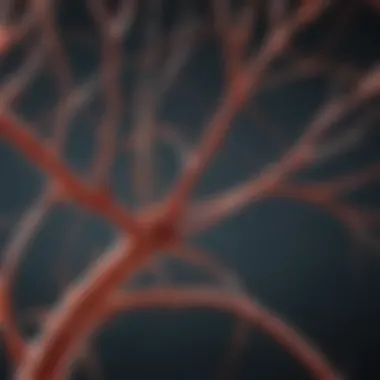Neuron Surface Markers: Understanding Neuroanatomy


Intro
Neuron surface markers play a pivotal role in the field of neuroscience. They serve as identifiers for various types of neurons, shedding light on the structure and function of the nervous system. Understanding these markers is crucial for mapping out neuronal populations, which is essential in both research and clinical contexts.
Various methodologies have been developed to identify neuron surface markers. These techniques are instrumental in uncovering the complexities of neuronal communication and their functional roles. The implications of these markers extend beyond basic neuroscience, touching on areas such as developmental biology and pathology. Moreover, their relevance in therapeutic applications makes them a subject of great interest.
This topic invites a detailed exploration into the concept of neuron surface markers. By analyzing their significance from multiple angles, we can appreciate how they contribute to our understanding of neuroanatomy and functionality. In this article, we will dissect their attributes, methodologies for their identification, and their pivotal role in neuroscience research.
Prelude to Neuron Surface Markers
Neuron surface markers are essential for understanding how different types of neurons operate within the complex architecture of the nervous system. These markers serve as identifiers for neuronal populations, guiding researchers in determining the unique features and functionalities of specific neuron types. Recognizing these surface markers aids in the classification and mapping of neurons, which is fundamental in both basic neuroscience and applied health research.
The significance of these markers extends beyond mere identification. They play crucial roles in various neural processes, including development, communication, and potential pathologies. By engaging in the study of neuron surface markers, scientists can unveil the intricate connections between neuron types and their physiological roles. This can illuminate ways in which certain neurons contribute to overall brain function and behavior, as well as signal the onset of neurological disorders when these markers are altered.
In this section, we first define what neuron surface markers are and discuss their importance in neuroscience. Then we will provide a brief historical context to show how the understanding of these markers has evolved over time.
Definition and Importance
Neuron surface markers are proteins or molecules found on the surface of neurons. They can participate in various cellular interactions, including adhesion, signaling, and transmission of information. Identifying these markers is crucial for characterizing neurons and understanding their roles. Different populations of neurons express distinct sets of these markers, indicating their specific functional roles in the nervous system.
The ability to define and classify neurons based on surface markers is particularly important in research. For instance, in developing therapies for various neurological diseases, understanding neuronal function and its alterations is key. When scientists can identify which markers are present or absent, they can better comprehend the implications of such changes and how they relate to conditions like Alzheimer's, schizophrenia, and multiple sclerosis.
Historical Context
The exploration of neuron surface markers has a rich and evolving history. Early studies focused primarily on the anatomical aspects of neurons. However, as techniques for examining cellular components advanced, interest in the functional implications of surface markers grew.
In the mid-20th century, methods such as immunostaining began to reveal the presence of specific proteins on neuron membranes, paving the way for a deeper understanding of neuron diversity. Researchers like Paul Greengard made significant contributions to identifying neurotransmitter receptors, which are pivotal surface markers. As tools and methodologies have become more sophisticated, a clearer picture of how these markers define neuron type and function has emerged, influencing therapeutic approaches and advancing knowledge of neurobiology.
Identifying Neuron Surface Markers
Identifying neuron surface markers is critical for understanding the complexity of neuronal identity and function. These markers serve as unique identifiers for different neuron types and assist researchers in mapping the intricate web of neural circuits. Accurate identification is fundamental for studying various aspects of neurobiology, such as cellular interactions, signaling pathways, and behavior patterns in neural systems. Furthermore, the specificity of neuron surface markers can significantly contribute to developments in both basic and translational neuroscience.
Techniques for Detection
Immunohistochemistry
Immunohistochemistry plays a vital role in the visualization and localization of neuron surface markers within tissue samples. This technique involves using antibodies to bind specifically to target antigens, allowing for precise detection under a microscope. One key characteristic of immunohistochemistry is its ability to preserve the morphological context of the neurons being studied. This is particularly beneficial for researchers as it provides spatial information that is crucial for interpreting functional roles of specific neuron populations. However, a challenge with this method is the potential for non-specific binding, which could lead to ambiguous results if not carefully controlled. Despite this, immunohistochemistry remains a favored choice due to its relatively straightforward application and ability to target a diverse range of markers.
Flow Cytometry
Flow cytometry offers a quantitative method to analyze the physical and chemical characteristics of cells. In the context of neuron surface markers, it allows for the rapid assessment of marker expression levels on isolated neuronal populations. The key characteristic of flow cytometry is its high throughput, enabling the analysis of thousands of cells in a short time frame. This high-dimensional output makes it popular for studying heterogeneous neuronal populations. One unique feature of flow cytometry is its capability to analyze multiple markers simultaneously, providing a comprehensive profile of neuronal characteristics. However, a limitation of this technique is that it typically requires dissociation of tissues, which can loss critical spatial information. Thus, researchers must weigh the benefits of quantitative analysis against the potential loss of contextual data.
In Situ Hybridization
In situ hybridization is a technique used to detect specific nucleic acid sequences within fixed tissues. This method is essential for studying gene expression and associated neuron surface markers. A significant aspect of in situ hybridization is its ability to provide information on gene expression at the cellular level while retaining the tissue's architecture. This characteristic makes it a favored technique in situations where spatial context is as crucial as gene expression data. One advantage is that it allows for the visualization of mRNA within individual cells, providing insights into their functional status. However, the technique requires an understanding of the target RNA sequences, which can limit its applicability if the sequences are not well characterized. Overall, in situ hybridization complements other detection methods by providing a different layer of information related to neuron surface markers.
Advantages and Limitations of Techniques
The selection of a technique for identifying neuron surface markers is often driven by the specific goals of a study. Each method comes with its advantages and disadvantages, which should be considered carefully:
- Immunohistochemistry is excellent for preserving morphology but may face issues with specificity.
- Flow Cytometry excels in high-throughput analysis but sacrifices spatial context for quantitative data.
- In Situ Hybridization allows for detailed gene expression profiling while keeping tissue integrity, yet it can be limited by the availability of suitable probes.
A comprehensive understanding of these techniques will enhance the ability to identify and characterize neuron surface markers effectively, fostering deeper insight into their biological roles in both health and disease.
Types of Neuron Surface Markers
Neuron surface markers are pivotal for understanding neuronal identity and function. They embody the characteristics that define neuron types, influencing not just their connectivity but also their role in brain functionality. This section elucidates the classifications and specific examples of neuron surface markers, which are essential for both basic neuroscience and potential clinical applications.


Classifications
Understanding the classifications of neuron surface markers is fundamental. This classification helps researchers to pinpoint specific markers for various neuronal populations, facilitating studies on their roles in health and disease.
Cell Adhesion Molecules
Cell adhesion molecules (CAMs) play a crucial role in the development and maintenance of neuronal networks. They facilitate cell-cell interactions, essential for the formation of synapses. A key characteristic of CAMs is their ability to mediate adhesion between neighboring neurons, which promotes stability in neural circuits. This is particularly beneficial because disrupted adhesion can lead to developmental disorders.
A unique feature of CAMs is their structural diversity, which allows them to perform various roles within the nervous system. However, one ponderous aspect is that alterations in CAM expression could contribute to neural pathologies, such as autism spectrum disorders. This dual role requires careful consideration when studying their functionality.
Neurotransmitter Receptors
Neurotransmitter receptors are essential for synaptic transmission and signal propagation in the nervous system. They enable neurons to communicate with one another by binding neurotransmitters, thus significantly influencing neuronal functionality. Neurotransmitter receptors are a popular focus in neuroscience because they are directly involved in excitatory and inhibitory signaling.
One prominent feature of these receptors is their specificity for particular neurotransmitters, which dictates neuronal response. This receptor specificity is advantageous in neuropharmacology; understanding these receptors can drive the development of targeted therapies. Conversely, the complexity of receptor interactions often leads to challenges in pinpointing precise therapeutic approaches due to their dynamic nature in the nervous system.
Ion Channels
Ion channels are integral in generating action potentials and neuronal excitability. They regulate ion flow across the neuronal membrane, influencing how neurons respond to stimuli. A noteworthy characteristic of ion channels is their fast gating mechanisms, allowing rapid depolarization, which is critical during action potential firing.
The unique feature of ion channels is their ability to be modulated by various factors, including voltage, ligands, and pharmacological agents. This makes them a promising area for research in developing treatments for conditions such as epilepsy and neural degeneration. However, one must consider that aberrations in ion channel function can lead to severe disorders, indicating a double-edged sword in their therapeutic potential.
Specific Examples
Discussing specific examples of neuron surface markers offers a more concrete understanding of their applications.
Markers
CD markers, or cluster of differentiation markers, are widely recognized in the field of immunology and neuroscience. They are used to identify and differentiate various immune and neuronal cell types. The key characteristic of CD markers lies in their standardization, which facilitates communication among researchers.
One unique feature of CD markers is their use in flow cytometry for detailed cellular analysis. This is beneficial for studying immune-affected conditions within the nervous system. However, the specificity of CD markers also presents challenges, as certain markers might be expressed in different cell types, necessitating additional markers for accurate identification.
CAMs
Besides their role in adhesion, CAMs also influence signaling pathways that can affect neuronal survival and plasticity. The key characteristic of CAMs is their involvement in both structural stability and signaling intricacies, making them crucial in understanding neural networks.
In this context, CAMs can be beneficial as potential therapeutic targets for disorders involving synaptic connectivity. Nonetheless, researchers must navigate the complexities of their diverse roles in the nervous system, where their dysregulation could lead to detrimental effects.
GLUT Receptors
Glutamate receptors, particularly the ionotropic and metabotropic types, are fundamental for excitatory neurotransmission. The key characteristic of GLUT receptors is their role in mediating synaptic transmission and plasticity. This is essential for learning and memory processes.
One unique feature of GLUT receptors is their involvement in various pathological states, such as stroke and neurodegenerative diseases. This makes them a focus of research for developing neuroprotective strategies. However, the excitotoxicity associated with overstimulation of these receptors poses a significant risk, highlighting the need for a balanced approach in therapeutic contexts.
Neuron surface markers are not merely identifiers; they serve as critical players in neuronal communication and functionality, offering insight into the complexities of the nervous system.
Neuron surface markers are not merely identifiers; they serve as critical players in neuronal communication and functionality, offering insight into the complexities of the nervous system.
Functional Roles of Neuron Surface Markers
Neuron surface markers serve vital roles across multiple functions in the nervous system. Understanding these roles can deepen insights into both normal brain function and pathological states. We categorize the functional aspects of neuron surface markers into three main areas: neural development, signal transmission, and neuroplasticity. Each category illustrates how these markers contribute to overall neuronal activity and connectivity.
During Neural Development
Neuron surface markers play a crucial part in the development of the nervous system. They guide the differentiation of neural progenitor cells into functional neurons. The expression of specific markers indicates the stage of development and the particular neuron subtype. For instance, cell adhesion molecules like N-CAM (neural cell adhesion molecule) are essential for the migration of neurons during embryonic development.
In addition to guiding migration, neuron surface markers are involved in establishing synapses. They help in recognizing partner cells and ensuring proper connectivity. Genetic or environmental disruptions affecting these markers can lead to malformations in neural circuits and contribute to neurodevelopmental disorders like autism.
In Signal Transmission


Signal transmission across neurons is heavily reliant on surface markers that function as receptors or channels. Neurotransmitter receptors, such as glutamate receptors, bind to their respective neurotransmitters, facilitating excitatory signaling. Conversely, inhibitory signaling is mediated by receptors like GABA receptors. These interactions are critical for maintaining synaptic efficacy and ensuring appropriate neural communication.
Furthermore, ion channels, as surface markers, regulate the flow of ions such as sodium, potassium, and calcium. Their opening and closing create action potentials, essential for transmitting signals along axons and across synapses. The precise balance and functioning of these markers are fundamental for real-time communication between neurons, impacting everything from reflexes to learning processes.
In Neuroplasticity
Neuron surface markers also play a fundamental role in neuroplasticity. This refers to the brain's ability to reorganize and adapt in response to experience or injury. Surface markers such as AMPA and NMDA receptors change in number and type during learning, influencing how synapses strengthen or weaken. This dynamic state allows for memory formation and skill acquisition, evidencing the adaptive nature of the brain.
In pathological conditions, alterations in these markers can hinder neuroplasticity. For example, in Alzheimer’s disease, the reduction in certain receptor types contributes to cognitive decline as synaptic connections weaken. Understanding the roles of neuron surface markers in neuroplasticity not only clarifies mechanisms of learning but also points to potential intervention strategies for restoring function after injury.
Neuron Surface Markers in Pathology
Neuron surface markers play a crucial role in understanding the pathology of various neurological conditions. Their expression can shift in response to disease, which provides insights into disease mechanisms and progression. By studying these alterations, researchers can gain a better understanding of how neuron populations function and how they are affected by various pathological processes.
Marker Alterations in Disease States
Neurons often undergo significant changes in surface marker expression during disease states. These changes can indicate how well neurons function and their overall health. For example, in neurodegenerative diseases, certain markers may be upregulated or downregulated, reflecting the underlying pathology. This alteration can serve as a biomarker for disease diagnosis and progression, making it vital for developing targeted therapies.
Implications for Neurological Disorders
Alzheimer's Disease
Alzheimer's disease is characterized by the accumulation of amyloid plaques and neurofibrillary tangles. Neuron surface markers, such as amyloid precursor protein, often display altered expression in this disorder. This change aids in identifying neurons affected by the pathology. Understanding these markers enhances the ability to track disease progression. Moreover, specific neuron populations can reveal how memory dysfunction occurs in Alzheimer's. This aspect makes Alzheimer's a particularly advantageous focus for discussions regarding surface markers.
Schizophrenia
Schizophrenia is associated with significant changes in neurotransmitter systems. Surface markers related to neurotransmitter receptors often show altered levels. For example, the expression of dopamine receptors may be affected, leading to the typical symptoms observed. The link between altered marker expression and the symptoms in schizophrenia underscores the disorder's complexity. This unique feature of schizophrenia emphasizes the need for targeted therapies that consider these markers to address symptoms more effectively.
Multiple Sclerosis
Multiple sclerosis involves the immune system attacking myelin, which leads to neuron damage. Surface markers like CD4 and CD8 T-cells play a significant role in the autoimmune response observed in this condition. By studying surface markers, insights can be gained into the mechanisms of neuron damage and repair. The unique aspect of how immune markers interact with neuronal markers in multiple sclerosis is particularly relevant for the development of future treatments. This dual focus on immune and neuronal markers offers advantages in understanding the multifaceted nature of the disorder.
Therapeutic Applications of Neuron Surface Markers
The study of neuron surface markers holds significant promise in the therapeutic context, particularly concerning diagnosis and treatment of neurological disorders. By pinpointing specific markers, researchers develop methodologies that can enhance therapeutic outcomes. This section will discuss how neuron surface markers function as biomarkers for diagnosis and how they can be effectively targeted for treatment purposes.
Biomarkers for Diagnosis
Neuron surface markers provide crucial information for diagnosing various neurological conditions. These markers can help in identifying the presence of certain diseases early. For example, changes in the expression of specific markers may correlate with the onset of disorders like Alzheimer's disease or schizophrenia.
- Differential Expression: Different neurons express varying levels of surface markers depending on their functional state or pathological condition. This differential expression assists clinicians in discerning normal from diseased cells.
- Non-Invasive Techniques: Advanced imaging technologies can facilitate the detection of these biomarkers non-invasively, allowing for more frequent assessments without the need for surgical procedures.
"Identifying neuron surface markers enables targeted interventions and personalized treatment strategies in neurology."
"Identifying neuron surface markers enables targeted interventions and personalized treatment strategies in neurology."
Given the importance of early diagnosis, leveraging these markers could lead to timely therapeutic interventions, ultimately improving patient outcomes.
Targeting for Treatment
Neuron surface markers also present avenues for targeted therapy in neurological disorders. Their unique expression profiles allow for the design of therapeutic strategies that specifically engage diseased cells, while sparing healthy ones.
- Monoclonal Antibodies: These can be engineered to recognize specific neuron surface markers, delivering drugs directly to affected cells. For instance, targeting CD markers may help in treating certain types of cancers that involve neuronal pathways.
- Gene Therapy: Techniques that employ neuron surface markers for delivery mechanisms hold potential for more precise therapies. By attaching therapeutic genes to antibodies that target specific markers, these treatments can increase effectiveness and reduce side effects.
In summary, neuron surface markers serve as a pivot for both diagnosis and targeted treatment strategies. Their capacity to delineate distinct neuron populations enhances our understanding of various neurological disorders and contributes to the innovation of therapeutic applications.
Future Directions in Research
The exploration of neuron surface markers stands at a critical juncture in neuroscience research. As advancements emerge in technology and methodologies, the potential for groundbreaking discoveries in neuroanatomy and functionality becomes more feasible. Future directions in this field are not just a matter of refining existing methods, but also an opportunity to reshape how we understand the nervous system. The complexity of neural networks and the intricacies of their functionalities necessitate a forward-thinking approach that integrates various innovative techniques.


Potential Innovations
Numerous potential innovations can enhance the study of neuron surface markers. These include:
- Next-Generation Sequencing (NGS): This technology can be employed to identify unique RNA profiles from different neuronal populations. NGS promises to reveal previously unknown markers and their roles in various neural contexts.
- CRISPR-Cas9 Technology: By enabling precise genetic modifications, CRISPR can create cellular models that lack specific surface markers. This approach allows researchers to examine those markers' functional roles more clearly.
- Advanced Imaging Techniques: New imaging modalities, such as super-resolution microscopy, can visualize neuron surface markers with greater precision in live tissues. This can aid in real-time observation of neuronal interactions and behaviors.
Implementing these innovations requires careful planning and consideration. The implications of these tools could transform our understanding of neuroanatomy significantly.
Interdisciplinary Approaches
Interdisciplinary approaches are essential for future research on neuron surface markers. The complexity of the nervous system often necessitates the collaboration of experts from various fields. Potential collaborations can include:
- Molecular Biology and Neuroscience: A partnership between these two disciplines can enhance the identification and understanding of molecular pathways influenced by neuron surface markers.
- Bioinformatics: Combining biological data with computational tools can help in analyzing large datasets generated from high-throughput techniques. This can lead to the discovery of novel markers and neural networks.
- Clinical Neuroscience: Insights into how neuron surface markers change in disease states can lead to practical applications in diagnostics and treatments. Collaborative research could bridge the gap between bench and bedside.
Collaboration among multiple disciplines offers the potential to accelerate discoveries and advance therapeutic applications.
Collaboration among multiple disciplines offers the potential to accelerate discoveries and advance therapeutic applications.
Focusing on these future directions presents both challenges and opportunities. The importance of continuous innovation and synergy among varied scientific fields cannot be overstated, as it will drive the understanding of neuron surface markers into new realms.
Ethical Considerations
In the realm of neuroscience, ethical considerations play a foundational role. This is especially true when it comes to the study of neuron surface markers. Understanding and manipulating these markers is crucial for delineating their roles within the nervous system. However, researchers must tread carefully in this domain to ensure that their work maintains high ethical standards.
Research Ethics
Research ethics in neuroscience encompasses various facets. One prominent aspect is the treatment of model organisms or human subjects. Ethical treatment necessitates informed consent when applicable, which ensures that participants understand the nature and implications of the research. Furthermore, when using animal models, researchers are tasked with adhering to regulations that prevent undue harm and distress.
Additionally, the potential benefits of neuroscience research should always be weighed against possible risks. Minimizing risks while maximizing benefits is an important principle. This is especially pertinent in studies involving therapeutic applications of neuron surface markers. Researchers must demonstrate that their findings contribute positively to the field and do not exploit vulnerable subjects for mere scientific inquiry.
Benefits of Ethical Research Practices
- Encourages public trust in scientific research
- Fosters collaboration across disciplines
- Promotes the responsible use of scientific advancements
Overall, these practices not only safeguard the rights and welfare of individuals involved but also reinforce the integrity of neuroscience as a discipline.
Implications of Manipulating Neural Markers
The manipulation of neuron surface markers has far-reaching implications. When researchers alter these markers, they affect neuronal identification and functionality. As such, there are several ethical concerns that must be addressed.
One significant risk is the potential for unintended consequences. Changes to neuron surface markers can lead to alterations in cell behavior, which may not only impact lab results but also future therapeutic approaches. For example, if specific markers are disrupted, it may contribute to a misunderstanding of neuron functionality leading to incorrect conclusions . Then there is the impact on neurological or psychological health. Ethical dilemmas arise when considering whether the benefits of manipulating neural markers for potential treatments outweigh the risks of adverse effects on patients.
"Manipulating neural markers responsibly is a critical balancing act; the quest for knowledge must not come at the expense of ethical integrity."
"Manipulating neural markers responsibly is a critical balancing act; the quest for knowledge must not come at the expense of ethical integrity."
Furthermore, there is the concern of dual-use research. This refers to research that can be used for both beneficial medical treatments and harmful purposes. Understanding the possible applications of research involving neuron surface markers can guide development while mitigating risks of misuse.
End
The conclusion serves as a crucial component of any analysis on neuron surface markers. It encapsulates the essence of the previous discussions, emphasizing the significance of these markers in neuroscience research. Their role in identifying various neuronal populations and understanding their functions cannot be overstated. As we have explored, neuron surface markers are pivotal in investigations of neural development, signal transmission, and neuroplasticity. Additionally, their alterations are often indicative of neurological disorders, such as Alzheimer’s disease and schizophrenia. This understanding is invaluable for identifying potential therapeutic targets and methodology in treatment approaches.
Recap of Key Findings
In this article, several key points emerged that highlight the importance of neuron surface markers:
- Identification and Characterization: Neuron surface markers play an essential role in distinguishing different types of neurons and their specific functions.
- Techniques for Detection: Methods such as immunohistochemistry, flow cytometry, and in situ hybridization are critical tools in detecting surface markers accurately.
- Functional Roles: These markers are involved in numerous physiological processes, from the early stages of neural development to various signaling mechanisms that underpin neuroplasticity.
- Pathological Insights: Changes in the expression of surface markers are relevant in various diseases, unlocking potential pathways for diagnosis and treatment.
Final Thoughts
In reflecting on the significance of neuron surface markers, one can appreciate their integral role in advancing our understanding of neuroanatomy and functionality. The implications of this research extend to different fields in neuroscience, opening avenues for innovative therapeutic strategies. As research progresses, the continuous exploration of neuron surface markers will undoubtedly reveal further insights and possibilities, enhancing our comprehension of the nervous system. The ethical considerations of manipulating these markers should also remain a vital aspect of future discussions, ensuring responsible usage in research and clinical applications.
Neuron surface markers are not merely cellular identifiers; they are keys to unlocking the complexities of neural function and pathology.
Neuron surface markers are not merely cellular identifiers; they are keys to unlocking the complexities of neural function and pathology.



